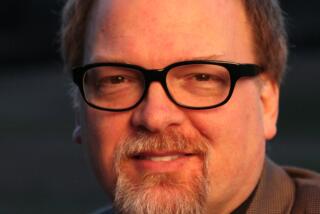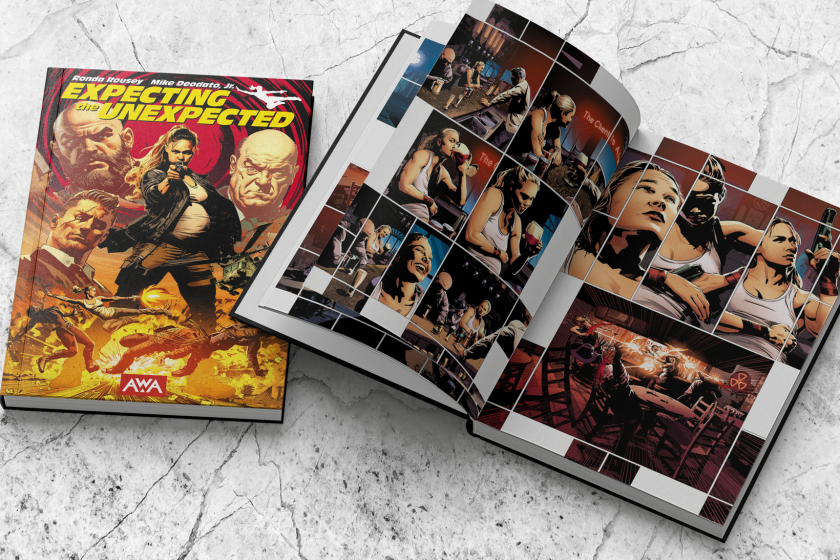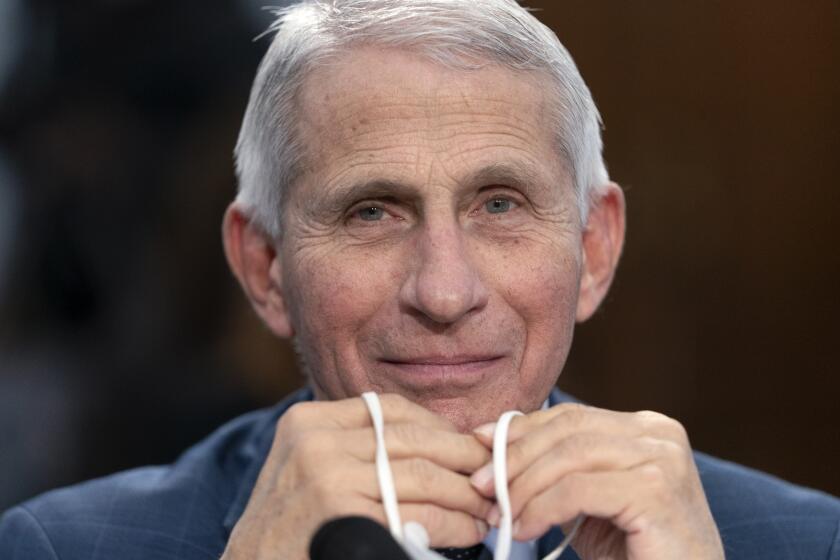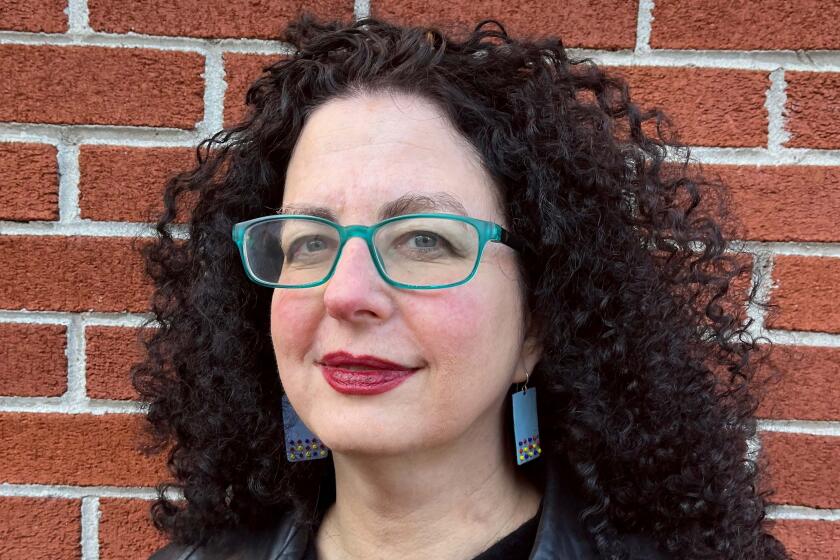Writing the Game of Life : Baseball inspires more books than any other sport. This season there’s a new crop of rookies, ready to tell their stories. Why? Most say in the field of dreams, readers and writers can find truths about the way we live.
It had been a punishing winter, and as he walked with his 5-year-old son through a muddy field, Bill Meissner considered it an omen when they spotted an old baseball, its cover rotting from snow and rain.
They had found balls before, but this one seemed different: Dark, gummy yarn burst out of the wrinkled horsehide, inviting a closer look.
“I could unroll this string and find out what’s inside,” said Meissner’s son, Nathan, tossing the first ball of spring into the air. “Can I try it?”
The boy put it on the ground and ran ahead, tugging the unwinding string like a kite over his shoulder. Suddenly, it snapped and Meissner tried to tell him. But the wind muffled his voice and all the father could do was watch his son disappear--the broken string and an unanswered question trailing behind.
“I love baseball and this is one real-life story that didn’t need editing,” says Meissner, the Minnesota author of “Hitting Into the Wind,” a new collection of short stories about the national pastime. “There was a sense of mystery, knowledge and loss all wrapped up into this one incident. And that’s what American baseball writing does when it succeeds--it can take you beyond the game into much larger questions.”
The answers may be elusive, but baseball poses more questions than any other sport. Each year, scores of new baseball-related titles flood the market--more than football, basketball, golf and hockey books combined. Although there are no exact figures showing how well these titles sell from one season to the next, that publishers keep producing them is significant.
They come in all varieties, from fiction and “tell-all” accounts by superstars, to essays by writers like Roger Angell, Thomas Boswell and Jim Murray. In recent years, encyclopedias and statistical compilations have become hugely popular, as have examinations of lesser-known subjects like the history of the Negro Leagues.
“You have more baseball books because the game itself is so conducive to thought and creative reflection,” says Steve Lehman, publisher of Elysian Fields Quarterly, a premier national baseball magazine. “Baseball is more leisurely, and it almost encourages the telling of great stories, which is what literature has always been about. The game is filled with real life, so that attracts writers as well as readers.”
*
Baseball, writing and life. That’s the top of the order in your local bookstore this season, and a perfect cure for winter blahs. If you’ve got the shakes in Los Angeles or the shivers back East, some newer books will remind you what’s really important.
Human psychology, for instance. You don’t know depression until you read “Chasing the Pennant” by David Plaut (Diamond Communications), a history of the 1962 race in which the Los Angeles Dodgers lost the National League flag to the San Francisco Giants on the last day of the season.
Looking for a revelation? Check out “Diamonds Are a Girl’s Best Friend,” edited by Elinor Nauen, (Faber and Faber) the first anthology of baseball writing by women. (See accompanying story.)
For cynics who think none of this impacts the real world, grab a copy of “Hardball” by Daniel Coyle (Putnam), the story of a Little League team from Chicago’s Cabrini Green housing project.
“We’ve got an interesting mix of baseball books this spring,” says Debra Powell, general manager of Sports Books in Los Angeles, the nation’s largest all-sports bookstore. “I’m not just talking about books by superstars that will get lots of attention. We’ve got some real gems out there this year.”
Powell has her eye on several new titles, such as “The Catcher Was a Spy” by Nicholas Dawidoff (Pantheon), the latest biography of fabled catcher Moe Berg, who was also a U.S. counterintelligence agent. Booksellers are also touting Bill James’ “The Politics of Glory” (Macmillan), a probing look at the Hall of Fame selection process.
Still, picking winners in the baseball book market is like evaluating rookies in spring training. Although early promise is great, veterans are a much better bet to make the best-selling team. Especially if they’re named Mickey Mantle--his autobiography “All My Octobers” is due from HarperCollins--or Tom Seaver, whose “The Art of Pitching,” has just been published by Morrow.
Publishers will be sending these and other big-ticket authors on national publicity tours, hoping to strike it rich with baseball fans. Yet, the real literary stars of 1994 won’t be pulling down millions in contracts and royalties. They’re unknown and they’re itching for a chance at the big time. You’d be wise to give them a shot . . . like any other hot prospect.
*
Take Meissner. He doesn’t just write baseball, he lives the damn game, playing with a bunch of guys in Minnesota called The Dead Ball Players Society. Pushing 45 and risking a bad back, Meissner pays the bills with a day job teaching creative writing at St. Cloud State University.
“Hitting Into the Wind” (Random House) is his first collection of short stories, and Meissner says he began collecting ideas for a baseball book several years ago. Some stories sprang from experience, like “The Unwinding,” the story of his son and the mysterious insides of a baseball. Others are more conventional fiction, like “Lights: Joe and Marilyn, an American Love Story,” about Joe DiMaggio and Marilyn Monroe.
Meissner’s decision to write about baseball followed his painful admission that he would never be good enough to play in the major leagues--a discovery made by millions of other Americans in their teens or early 20s.
“I reached a stopping point when I realized that, because it was a clear difference between my reality and my dreams,” he says. “But then I came back to baseball in my 30s, after the Vietnam War. And when I came back, I came back full force. For me, baseball brings back the excitement of childhood and boyhood . . . and it was easy to connect that with writing.”
His short stories blend the ironic edge of Raymond Carver and the poetic rhythms of Richard Hugo, using baseball as a touch point for life experiences: the frustrations of youth, faltering marriages, aging. And the crushing recognition that one’s life will be ordinary, not star-crossed. Meissner also celebrates his boy’s awakening love for baseball, and the rich spiritual bonds it can forge between generations.
“One thing you won’t see in my book is Rocky hitting a home run with two outs in the ninth inning to win the game,” he says. “It deals more with subtle changes in people’s lives. Real people. Men and women. And sometimes those truths can hit you right between the eyes.”
*
Like its name, Daniel Coyle’s “Hardball” rockets in high and tight. It’s an unforgettable glimpse of American inner-city life and makes a case for baseball as the great racial equalizer.
Coyle, an editor at the Chicago-based Outside Magazine, was among a handful of young white professionals who agreed in 1991 to help coach a baseball team of 9- to 12-year-old kids from the tough Cabrini Green housing project. At the time, the Near North Little League/African-American Youth League was the only group of its kind based in an American housing project.
The growing pains were severe: Black coaches connected with the Kikuyus, named after an African tribe, were openly skeptical that the white coaches would lose interest and drift away. The young players were wary of Coyle and others, wondering why they had gotten involved.
At times, the violence that engulfs Cabrini Green hit home with a vengeance. Coyle remembers once fleeing gunfire dozens of yards away, and the book is filled with tragedies that kids in the projects see every day. Toward the end of “Hardball,” for example, the chronic absence of one player is finally explained: He had to be with a father dying of AIDS.
Somehow, the ragtag team winds up in the championship game by the end of the book, and Coyle’s narrative ends on an upbeat note: The league will continue to grow. This season, he and other sponsors have arranged for the Kikuyus to train in the Michigan countryside. Coyle can hardly wait.
“In the beginning, you had coaches from one end of society and then these kids from the other end of society,” he says. “They had to relate across this chasm, and they managed to do it, because they had baseball in common.
“So ultimately, this was a book that used baseball to look at America’s social problems. I used a quote in the book which sums it up, for better or worse. It’s by Jacques Barzun, the writer, and he said: ‘Whoever wants to know the heart and mind of America had better learn baseball.’ ”
*
They could also check out the Dodgers-Giants rivalry.
On the last day of the 1993 season, the Los Angeles Dodgers trounced the San Francisco Giants, killing their pennant hopes. In the locker room after the game, LA manager Tommy Lasorda was raving about payback . . . and the past.
In 1951, he told listeners, the New York Giants stunned the Brooklyn Dodgers by stealing the pennant from them on the last day of the season. In 1982, the Giants’ Joe Morgan hit an epic home run and knocked the Dodgers out of the race. In 1991, the Giants, in a season-ending series, again dashed the Dodgers’ chances of winning the flag.
But the worst insult was 1962. In a bitter race, Los Angeles led San Francisco by four games with only seven to go till the end of the season. Suddenly, the Dodgers ran out of gas and ended up in a tie with their hated rivals. They lost the deciding playoff game after leading the Giants 4-2 at Dodger Stadium in the top of the ninth. There was no joy in smogville.
If you’re a Dodger fan, it’s a memory to forget. But that’s going to be tough with the publication of David Plaut’s “Chasing October: The Dodgers-Giants Pennant Race of 1962.” For Los Angeles die-hards, reading Plaut’s vivid history is the literary equivalent of drinking hemlock.
It’s all there in gory detail: The doomed Dodger team with stars like Sandy Koufax, Don Drysdale, Maury Wills and Tommy Davis. The murderous San Francisco offense, led by Willie Mays, Orlando Cepeda, Felipe Alou and Willie McCovey.
Yet Plaut has written more than a conventional baseball recap. He’s tried to capture the times, showing how America was enjoying its last pennant race in a bubble of innocence, one year before the murder of John F. Kennedy. In Los Angeles, Hollywood celebrities descended on Dodger Stadium and more team members made TV appearances than in any other season. It was the year of Danny Kaye’s immortal “Dodgers Song” and the beginning of Koufax-mania.
Meanwhile, Bay Area writers tormented Angelenos with glee. The San Francisco Chronicle’s Art Rosenbaum referred to LA as “The Smodgers” and derided La-La Land as “a city whose women would attend the opera in leopard shirts and toreador pants, if indeed they attended the opera at all.”
This acrimony has endured, but Los Angeles and San Francisco fans worked themselves into a lather over the 1962 contest that has never been equaled, Plaut contends. There have been other historic baseball rivalries--such as New York and Boston--but none quite compare for vitriol.
“You can talk all you want about Brooklyn and New York, Minneapolis and St. Paul, Dallas and Fort Worth,” says Hall-of-Famer Joe Cronin, in Plaut’s book. “But there are no two cities in America where the people want to beat each other’s brains out more than San Francisco and Los Angeles.”
Plaut, who reviews books for USA Today’s Baseball Weekly, says the remarkable 1962 race reminds us decades later how baseball can stir our deepest passions. Win or lose, these feelings linger long after the season ends.
“For those who were there, 1962 was a race you never forget,” Plaut says. “So hopefully, this book will stick with you. Like baseball itself.”
More to Read
Sign up for our Book Club newsletter
Get the latest news, events and more from the Los Angeles Times Book Club, and help us get L.A. reading and talking.
You may occasionally receive promotional content from the Los Angeles Times.






